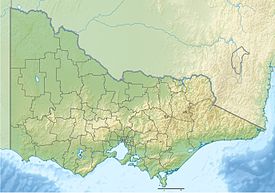Mount Macedon


Mount Macedon (/ˈmæsədən/ MASS-ə-dən;[4] Aboriginal Woiwurrung language: Geboor or Geburrh)[3] is a dormant volcano that is part of the Macedon Ranges of the Great Dividing Range, located in the Central Highlands region of Victoria, Australia. The mountain has an elevation of 1,001 metres (3,284 ft) with a prominence of 643 metres (2,110 ft)[1] and is located approximately 65 kilometres (40 mi) northwest of Melbourne.
Etymology
The mountain is known as Geboor or Geburrh in the Aboriginal Woiwurrung language of the Wurundjeri people.[3]
The mountain was sighted by Hamilton Hume and William Hovell on their 1824 expedition to Port Phillip from New South Wales. They named it Mount Wentworth.[5] It was renamed Mount Macedon by explorer Major Thomas Mitchell who ascended the mountain in 1836.[3] He named it after Philip of Macedon in honour of the fact that he was able to view Port Philip from the summit. Several other geographic features along the path of his third Australia Felix expedition were named after figures of Ancient Macedonia including the nearby Campaspe River and Mount Alexander near Castlemaine (named after Alexander the Great).
History
At the base of Mount Macedon is an axe-grinding site, a large sandstone boulder with thirty-one grooves made by the sharpening of stone axes. This is an important cultural heritage site for the Wurundjeri tribe.[6][7]
Summit

The highest peak of Mount Macedon is Camel's Hump, or Camels Hump,[8] one of three mamelons in the area, the rocky outcrop of a once small steep-sided volcano, with an elevation estimated at 1,011 metres (3,317 ft),[citation needed] and at times is covered in snow. Camel's Hump, together with Hanging Rock and Croziers Rocks[citation needed] are igneous trachyte rocks of the crag and are favoured by rock climbers. The mountain has become a popular venue for sport climbing and for families, due to its proximity to Melbourne.
The view from the summit of Mount Macedon is spectacular, and takes in Melbourne city, the Dandenong Ranges and the You Yangs near Geelong.
Mount Macedon Memorial Cross
Mount Macedon Memorial Cross is a 21-metre (69 ft) high monument standing near the summit of the mountain, in an area called Cross Reserve. It was established in 1935 by William Cameron, an early resident of the town of Mount Macedon, as a memorial to his son and others who had died in World War I.[9]
Climate
Total rainfall approaches 1,000 millimetres (39 in) annually, reaching a maximum in winter, with minimum amounts occurring during the summer months of January to March. Snowfalls occurs on 15–20 days a year, with snow lying occurring on 10–15 days a year.[10] As with the entire region, Mount Macedon is susceptible to severe frost, generally between the months of May and September, with light frosts throughout the rest of the year and minimal frost between January and March. Extreme minimums have been recorded near −9 °C (16 °F). A feature of the region in winter is the occasional appearance of black ice.[10]
Notable events
On 8 November 1948, Douglas DC-3 VH-UZK operated by Australian National Airways crashed on Mount Macedon a few minutes after leaving Essendon Airport. The pilot and first officer died; the cabin crew and all 19 passengers survived, with relatively minor injuries.[11] The event is commemorated on a plaque in Cross Reserve.[12][13]
See also
References
- ^ a b c "Mount Macedon, Australia". Peakbagger.com.
- ^ "Mount Macedon". Gazetteer of Australia online. Geoscience Australia, Australian Government.
- ^ a b c d Milbourne, Jean (1978), Mount Macedon: Its History and its Grandeur, Kyneton, Victoria: (self published), pp. 10, 14, ISBN 0-9595225-0-6
- ^ Macquarie Dictionary (4th ed.). Melbourne, Victoria: The Macquarie Library Pty Ltd. 2005. ISBN 1-876429-14-3.
- ^ Bland, William; Hovell, William Hilton; Hume, Hamilton (1831), Journey of discovery to Port Phillip, New South Wales by Messrs. W.H. Hovell, and Hamilton Hume in 1824 and 1825, Sydney
- ^ "Organisational Protocols for recognising traditional owners/custodians" (PDF). maggolee.org.au. November 2016. Retrieved 18 February 2019.
- ^ "Management of Wurundjeri Properties & Significant Places". Wurundjeri Tribe Council. Retrieved 18 February 2019.
- ^ "Camels Hump". Macedon and Mt Macedon Region. Macedon and Mt Macedon Business and Tourism Association Inc. 2014. Retrieved 22 January 2013.
- ^ "Mount Macedon Memorial Cross". monumentaustralia.org.au. Retrieved 16 October 2016.
- ^ a b Central Ranges Weather Discussion Archived 18 October 2006 at the Wayback Machine
- ^ "Two Killed in Air Crash on Mt Macedon". The Canberra Times. 9 November 1948. Retrieved 16 October 2016.
- ^ "Kurana Memorial". mountmacedon.org. Retrieved 16 October 2016.
- ^ ""Kurana" Plane Crash". monumentaustralia.org.au. Retrieved 16 October 2016.
External links
- RockClimbing.com
- "Macedon Regional Park: Park notes" (PDF). Parks Victoria. Government of Victoria. December 2010. Archived from the original (PDF) on 13 April 2012. Retrieved 22 January 2014.
- v
- t
- e
- William (1,167 m or 3,829 ft)
- Difficult
- Wilson
- Zero (364 m or 1,194 ft)
| Bogong High Plains |
|
|---|---|
| Cathedral Range |
|
| Cobberas Range |
|
| Cobbler Plateau |
|
| Other |
|
mountain ranges
| Central Highlands |
|
|---|---|
| Dandenong Ranges |
|
| Pyrenees Ranges |
|
| Strzelecki Ranges |
|
| Other |
|














